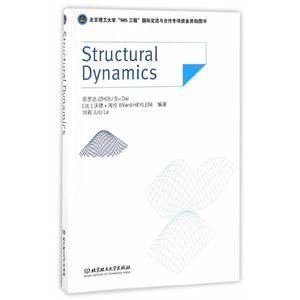1 Introduction to Structural Dynamics1.1 Essential Characteristics and Basic Assumptions1.1.1 Essential Characteristics1.1.2 Basic Assumptions in Structural Dynamics of This Book1.2 Missions of Structural Dynamics1.2.1 Response Analysis1.2.2 Inverse Problem of Type I: System Identification1.2.3 Inverse Problem Type II: Load Identification1.2.4 Vibration Control1.3 Types of Dynamic Loads1.3.1 Periodic Load1.3.2 Impulsive Load1.3.3 Random Load1.4 Formulation of the Equations of Motion1.4.1 Direct Equilibration Using d'Alembert's Principle1.4.2 Variational Approach1.5 Continuous and Discrete Structural SystemsReferences
2 Time-Domain Analysis of Continuous Systems2.1 Free Transverse Vibration of Strings2.2 Free Axial Vibration of Elastic Rods2.3 Free Torsional Vibration of Cylinder Rods2.4 Free Transverse Vibration of Euler-Bernoulli Beams2.4.1 Simple Supported Beams2.4.2 Cantilever Beams2.4.3 Fixed-Fixed Beams2.4.4 Free-Free Beams2.5 Free Transverse Vibration of Rectangular Thin Plates2.5.1 Kinematic Description2.5.2 Equilibrium Equation2.5.3 Boundary Conditions2.5.4 Solutions of Rectangular Thin Plates with Simple-supported Edges2.6 Some Properties of Natural Modes2.6.1 Orthogonality of Mode Shapes2.6.2 Modal Scaling2.6.3 Expansion Theorem2.6.4 Rayleigh QuotientProblemsReferences
3 Time-Domain Analysis of SDOF Systems3.1 From Continuous Systems to Generalized SDOF Systems3.1.1 Historical Rayleigh's Method3.1.2 An Improved Approach of Rayleigh's Method3.2 Mathematical Modelling of Lumped-Parameter Systems3.2.1 Direct Equilibration Modeling Using d'Alembert's Principle3.2.2 Modeling Based on Principle of Virtual Displacements3.3 Free Vibration of SDOF Systems3.3.1 Free Vibration of Undamped SDOF Systems3.3.2 Free Vibration of Viscous-Damped SDOF Systems3.4 Dynamic Behavior of Undamped SDOF Systems under Harmonic Excitation3.5 Viscous-Damped SDOF Systems to Harmonic Excitation3.5.1 General Solution3.5.2 Steady-State Response3.5.3 Complex Expression of the Response3.5.4 Resonance Response3.5.5 Forced Vibration by Support Motion3.5.6 Vibration Isolation3.5.7 Motion Transducer3.6 Expansion to Periodic Excitation via Fourier Series3.6.1 Fourier Series for Arbitrary Periodic Functions3.6.2 Steady-State Response under Arbitrary Periodic Excitations3.7 Response to Impulsive Loading3.7.1 Pulse Excitation3.7.2 Shock Response Spectrum3.7.3 Shock Isolation3.8 Response of SDOF Systems in Case of the General Dynamic Excitation3.8.1 Impulse Function3.8.2 Impulse Response3.8.3 Duhamel Integration3.8.4 Arbitrary Support Motion3.9 Damping3.9.1 Damping Models in Structural Dynamics3.9.2 Energy Losses and Equivalent Viscous Damping3.9.3 Illustration of the Errors Due to the EquivalenceProblemsReferences
4 Time-Domain Analysis of MDOF Systems4.1 Continuous Systems to MDOF Systems: Discretization Approaches4.1.1 Direct Lumped-Parameter Methods4.1.2 Generalized Displacements & Rayleigh-Ritz's Methods4.1.3 Assumed Mode Method: a Realization of General Rayleigh-Ritz Methods4.1.4 Choosing the Shape Functions4.1.5 Finite Element Method4.2 Modeling of Equations of Motion for MDOF Systems4.2.1 Direct Equilibration Modeling Using d'Alembert's Principle4.2.2 Modeling with Principle of Virtual Displacements4.2.3 Modeling with Lagrange's Equations4.3 Free Vibration of Undamped MDOF Systems4.3.1 Eigenvalue Problem, Natural Frequencies and Mode Shapes4.3.2 Orthogonality4.3.3 Modal Scaling4.3.4 Eigenvalue Separation Property4.4 Rayleigh and Rayleigh-Ritz's Methods for MDOF Systems: Model Reduction4.4.1 Rayleigh Quotient for MDOF Systems4.4.2 Rayleigh's Method for MDOF Systems4.4.3 Rayleigh-Ritz's Method for MDOF Systems4.4.4 Assumed Mode Method for MDOF Systems4.5 MDOF Systems with Rigid-Body Modes4.5.1 Small Fictitious Stiffness4.5.2 Eigenvalue Shifting4.5.3 Constraining of Rigid-Body Modes4.6 Damping in MDOF systems4.7 Numerical Evaluation of Responses of MDOF Systems4.7.1 Numerical Derivatives4.7.2 Central Difference Method4.7.3 Newmark-β Method4.8 Dynamic Response of MDOF Systems: Mode Superposition Method4.8.1 Transformation of Coordinates4.8.2 Modal Damping4.8.3 Initial Conditions in Modal Coordinates4.8.4 Mode Superposition for Free Vibration of Undamped MDOF Systems4.8.5 Mode Superposition of Free Vibration of Damped MDOF Systems4.8.6 Mode Superposition of Forced Vibration of Undamped MDOF Systems4.8.7 Mode Superposition of Forced Vibration of Damped MDOF Systems4.8.8 Mode-Displacement Solution and Mode-Acceleration SolutionProblemsReferences
5 Frequency-Domain Analysis5.1 Frequency-Domain Analysis of SDOF Systems5.1.1 System Equations and Transfer Function5.1.2 Poles, Natural Frequencies, Damping Ratio and Residues5.1.3 Transfer Function Plots5.1.4 Frequency Response Function and Impulse Response Function5.1.5 Influence of Mass, Damping and Stiffness Changes -.5.2 Frequency-Domain Analysis of MDOF Systems5.2.1 System Equations and Transfer Function5.2.2 Poles, Natural Frequencies and Damping Ratio5.2.3 Modal Vectors and Residues5.2.4 Modal Participation Factors5.2.5 Frequency Response Function Matrix and Impulse Response Function Matrix5.2.6 Undamped and Proportionally Damped Systems5.2.7 Orthogonality5.2.8 Modal Vector Scaling5.2.9 Numerical and Experimental ApproachesReferences
6 Experimental Modal Analysis and Applications6.1 Basic Modal Model Equations6.1.1 Modal Model6.1.2 State Space Model6.1.3 Rational Fraction Polynomial Model6.2 Modal Parameter Estimation6.2.1 Basic Concept6.2.2 SDOF Methods6.2.3 MDOF Time-Domain Methods6.2.4 MDOF Frequency-Domain Methods6.2.5 Output-Only or Operational Modal Analysis6.2.6 Conclusions6.3 Modal Validation6.3.1 Modal Scale Factor and Modal Assurance Criterion6.3.2 Mode Participation6.3.3 Reciprocity6.3.4 Mode Complexity6.3.5 Modal Phase Collinearity and Mean Phase Deviation6.3.6 Modal Confidence Factor6.3.7 Synthesis of Frequency Response Functions6.3.8 Discussion6.4 Applications of Modal Parameters6.4.1 Forced Response Analysis6.4.2 Sensitivity Analysis6.4.3 Structural Dynamics Modification & Assembly6.5 Combining Numerical and Experimental Models6.5.1 Model Updating6.5.2 Pre-Test Analysis
References

















